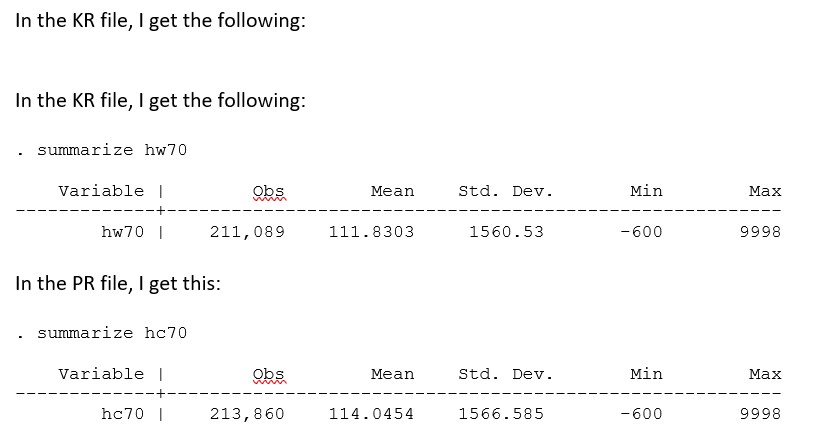| Stunting indicators in KR vs. PR file [message #13405] |
Tue, 31 October 2017 23:22  |
 dflood011
dflood011
Messages: 7
Registered: October 2017
|
Member |
|
|
Hi DHS team,
I am using the Guatemala 2015 DHS dataset to analyze child stunting risk factors.
Using the Household (PR) file, I am able to replicate the stunting prevalence rates from the DHS report. However, I am wondering why I am getting such dramatically different numbers when I use the Children's file (KR)
My understanding is that the children in the KR file are a subset of children in the PR file. So it would make sense to have slight differences in the numbers between the two files.
Unweighted PR analysis: 6,607 stunted children out of 12,258 total children (53.9%)
Unweighted KR analysis: 8,170 stunted children out of 11,444 total children (71.4%)
But why would the percentages be so vastly different? Any why would there be MORE stunted children in the KR file if this is a subset of PR?
I have a feeling I am missing something obvious. Any help or guidance would be appreciated.
|
|
|
|
| Re: Stunting indicators in KR vs. PR file [message #13498 is a reply to message #13405] |
Fri, 10 November 2017 10:42   |
Liz-DHS
Messages: 1516
Registered: February 2013
|
Senior Member |
|
|
Dear User,
Here is a description of the two types od data files you reference:
Quote:
Household Listing Data - Household Member Recode (PR)
This dataset has one record for every household member. It includes variables like sex, age, education, orphanhood,
height and weight measurement, hemoglobin, etc. It also includes the characteristics of the households where the individual
lives or was visiting. The unit of analysis (case) in this file is the household member.
Quote:
Children's Data - Children's Recode (KR)
This dataset has one record for every child of interviewed women, born in the five years preceding the survey. It
contains the information related to the child's pregnancy and postnatal care and immunization and health. The data for the
mother of each of these children is included. This file is used to look at child health indicators such as immunization
coverage, vitamin A supplementation, and recent occurrences of diarrhea, fever, and cough for young children and treatment
of childhood diseases. The unit of analysis (case) in this file is the children of women born in the last 5 years (0-59 months).
|
|
|
|
|
|
|
|
|
|
|
|
|
|
|
|
| Re: Stunting indicators in KR vs. PR file [message #25016 is a reply to message #24101] |
Fri, 19 August 2022 19:40   |
 AkhilK28
AkhilK28
Messages: 19
Registered: February 2022
|
Member |
|
|
Then shouldn't it mean that the KR stunted children population should be lower than the PR stunted population? If it was copied from the PR --> KR, then why does KR have a higher stunted N of children? PR includes all children living with mother or otherwise whereas KR only contains living with mother so therefore KR should be less than PR but in actuality KR has a higher N of stunted children in NFHS-4!
[Updated on: Fri, 19 August 2022 19:41] Report message to a moderator |
|
|
|
| Re: Stunting indicators in KR vs. PR file [message #25036 is a reply to message #25016] |
Mon, 22 August 2022 09:27  |
 Bridgette-DHS
Bridgette-DHS
Messages: 3230
Registered: February 2013
|
Senior Member |
|
|
Following is a response from DHS Research & Data Analysis Director, Tom Pullum:
Stunting is based on the HAZ, the height-for-age Z score. I checked how many children have a HAZ score in the KR and PR files.

That is, there are 211,089 measured children in the KR file and 213,860 in the PR file. The N is smaller in the KR file than in the PR file, as you would expect. I don't see how you could have gotten the reverse.
Note that the KR file includes children who died, and children who are not living with the mother and for that reason there are children in the KR file who are not in the PR file. The Z scores--and stunting, etc.--are only obtained for children who are alive and in the household and whose height and weight were measured. There are more children with Z scores in the PR file than in the KR file because the height and weight measurements are part of the household survey and there are a few children in the household survey whose mother had died or is living elsewhere.
-
 Attachment: hw70.jpg
Attachment: hw70.jpg
(Size: 46.18KB, Downloaded 1015 times)
|
|
|
|